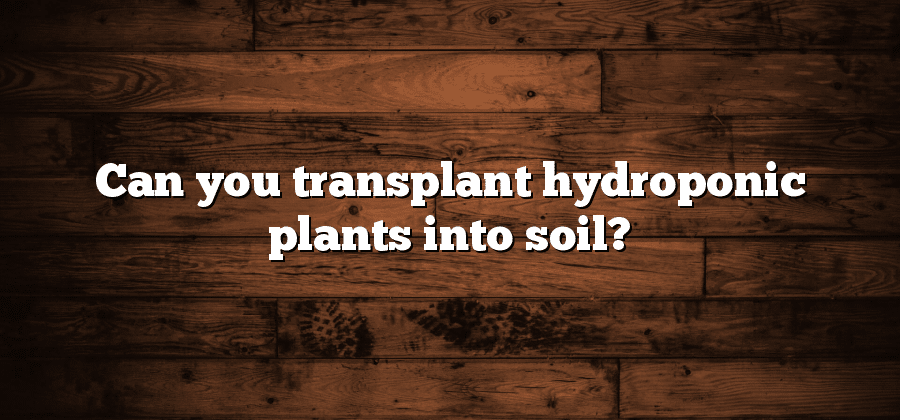Advantages of transitioning hydroponic plants
Hydroponic gardening is gaining popularity among both home gardeners and commercial growers due to its numerous advantages. One of the key advantages of transitioning hydroponic plants to traditional soil-based cultivation is the ability to expand the growing space. While hydroponic systems are often compact and space-efficient, they do have limitations in terms of the number of plants that can be grown. By transplanting hydroponic plants into soil, growers can take advantage of larger garden beds or outdoor spaces, allowing for increased plant production and variety.
Another advantage of transitioning hydroponic plants is the potential for reduced costs. Hydroponic systems require specialized equipment, such as grow lights, pumps, and nutrient solutions, which can be costly to set up and maintain. By transitioning to traditional soil-based cultivation, growers can eliminate or reduce these ongoing expenses. Additionally, the use of soil reduces the need for carefully balanced nutrient solutions, as the plants can draw nutrients directly from the soil. This can lead to a decrease in the overall cost of inputs, making soil-based cultivation a more affordable option for many growers.
Key considerations before transplanting
When it comes to transplanting hydroponic plants, there are several key considerations that must be taken into account. First and foremost, it is crucial to evaluate the overall health and growth of the plants before making any decisions. This involves closely inspecting the roots, leaves, and stems for any signs of disease or pest infestation. By identifying any potential issues beforehand, necessary treatments can be implemented to ensure the successful transition of the plants.
Another important consideration is the timing of the transplant. It is essential to choose an appropriate time when the plants are in their optimal growing phase and actively producing new roots and shoots. Transplanting during this period will minimize the shock and stress experienced by the plants, increasing the likelihood of successful adaptation to a new environment. Additionally, maintaining a consistent and favorable environmental condition, such as temperature and humidity, is vital throughout the transplant process to promote healthy growth and prevent any setbacks.
Preparing hydroponic plants for soil transplantation
When transitioning hydroponic plants to soil, proper preparation is essential to ensure a successful transplant. One important step is to gradually acclimate the plants to the different growing conditions they will encounter in soil. This can be done by introducing small amounts of soil into the hydroponic system, allowing the plants to gradually adjust to the new substrate. By slowly increasing the amount of soil over a period of time, the plants will have a smoother transition and be better equipped to adapt to the changes in nutrients and water availability.
Additionally, it is crucial to address any potential pests or diseases before transplanting hydroponic plants into soil. Soil-borne pests and pathogens can pose a threat to the health and productivity of the plants. Prior to the transplant, it is recommended to thoroughly clean and disinfect the containers, tools, and any other equipment that will come into contact with the soil. This will help remove any lingering pests or pathogens and minimize the risk of infestation or disease transmission. Taking these precautionary measures will significantly increase the chances of a successful transition from hydroponics to soil.
Choosing the right soil for transplanting
When it comes to transplanting hydroponic plants into soil, choosing the right soil is crucial for their successful adaptation and continued growth. The soil you select should be well-balanced, rich in nutrients, and have good drainage capabilities. A high-quality potting mix that consists of a blend of organic matter, such as compost, peat moss, and vermiculite or perlite, is often recommended. This kind of soil provides a good foundation for the roots to establish themselves and ensures adequate water retention, allowing for optimal nutrient uptake.
Additionally, it is essential to consider the specific needs of the plants you are transplanting. Some plants require a specific pH level in the soil, so it’s important to choose a soil mix that aligns with these requirements. Conducting a soil test can help determine the pH and nutrient levels of the soil, enabling you to make informed decisions about the amendments or additives needed to create a suitable environment for your plants. Remember, the goal is to mimic the ideal conditions of your hydroponic system as closely as possible in the new soil environment, providing the plants with the necessary support for their transition and ongoing development.
Transplanting hydroponic plants step-by-step
One of the key steps in transitioning hydroponic plants to soil is the actual transplanting process. This step-by-step guide will walk you through the necessary actions to ensure a successful transfer.
First, you should prepare the new soil by digging a hole that is deep and wide enough for the plant’s root system. Gently remove the plant from its hydroponic container, being cautious not to disrupt the delicate roots. Make sure to handle the plant by the base of the stem, rather than the leaves, to prevent damage. Once the plant is out, carefully loosen any excess hydroponic medium from the roots, allowing them to breathe in the new soil. It’s important to avoid any abrupt movements or pulling on the roots, as this can cause stress and harm the plant’s overall health.
Next, place the plant in the prepared hole and ensure it is positioned upright. Gradually backfill the hole with soil, gently firming it around the roots to provide stability. Make sure to not compact the soil too tightly, as it may hinder the plant’s ability to absorb nutrients and water. Once the transplant is complete, thoroughly water the plant to help settle the soil and provide hydration to the newly transplanted roots. It is advisable to keep the plant in a shady area for a few days to allow it to acclimate to its new environment before exposing it to full sun.






